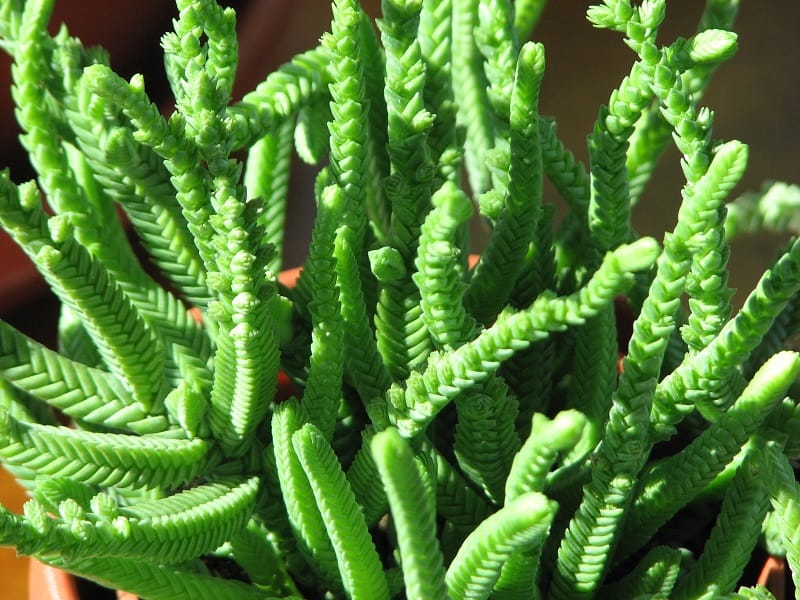The Crassula Muscosa (Watch Chain Plant) is a succulent plant belonging to the Crassulaceae family.
This species is native to the African continent, specifically South Africa.
It is a small plant (reaches between 30-45 cm maximum height) and very branched.
The stems in this plant are succulent and very thin, mainly observed, the leaves; these are erect but tend to bend over time.
The leaves are arranged in linear rosettes of 4 rows of leaves arranged in an upright position that are placed one above the other (the rosettes).
This plant is multiplied asexually by a constant and irregular branching of the stem that will eventually form a small but very dense plant (foliage).
The leaves are small, thick and pointed at their apex (some tend to be rounded).
They are very small reaching less than 0.5 cm long.
Leaf rosettes are compacted a lot making the visibility of the stem of this plant impossible.
The leaves are completely green varying in some cases the intensity (the intense sun causes the leaves to become darker; between gray and red).
Both the arrangement of the leaves and the high branching of the stem cause this plant to be so curious and beautiful.
The flowers are arranged in small lateral inflorescences that arise from the larger stems (usually).
They are very small in size and number and not very showy; they are almost indistinguishable because of their coloration (yellow-green) they can be confused between the leaves.
The flowering season begins in late summer and early fall.
They can bloom at any time of the year if temperatures remain above 24 ° C.
Fun Fact: This plant is very long reaching more than 20 years if it is grown in a pot with the necessary care.
You may like this plant.
Tips to take care of the crassula muscosa (watch chain plant)
This species is quite resistant to the climates and droughts present in the tropics.
In tropical countries, it is very easy to grow but in temperate areas, you must take more precautions.
To cultivate this plant you must take into account the following aspects.
Illumination
Unlike many succulents, the Crassula Muscosa species prefers to grow in shaded-somewhat lit places.
Do not locate in full sun (burn its leaves).
Temperature
It prefers to grow mainly at temperatures above 20 ° C and remain stable throughout the year.
Temperatures below 10 ° C can deteriorate or kill our plant. It does not support frost.
Humidity
It grows best in environments where the relative humidity is quite low (dry heat).
Watering
We must water frequently in warm times because the substrate tends to dry quickly.
In cold times we should only water it when the substrate is completely dry.
Substrate
We must provide a substrate with good drainage and rich in organic matter.
To improve drainage it is recommended to use small stones, soil and sand.
Where to plant
It can be planted easily in pots but you must transplant them every 1-2 years for larger ones and favor growth.
Propagation
Very easy! We can reproduce it by cuttings of the stems that appear when branching.
We can also use leaves to obtain new plants.
Pests and diseases:
The main pests that attack this plant are aphids (aphids) and mealybugs that we must eliminate with insecticides.
Excess watering and / or substrate pooling favors the appearance of fungi and root rot.
Conclusion
The Crassula is made up of more than 600 species of succulent plants originating, almost all, from South Africa.
They are usually used in indoor pots or greenhouses and also, if the weather allows it, in rockery.
Although they can live in full sun exposures they prefer a light shade outside or a very bright location indoors.
They do not tolerate temperatures below 5 ° C.
A good soil would be a mixture of peat or leaf mulch with enough siliceous sand.
In summer, watering will be medium, waiting for the land to dry before the next water supply.
In winter they require a certain rest, so the risks will be greatly reduced.
They appreciate a light fertilizer with organic matter every 2 years.
They do not need pruning.
They do not usually present problems with pests and diseases; we just have to avoid watering them in excess.
They can be multiplied from stem cuttings quite simply.
